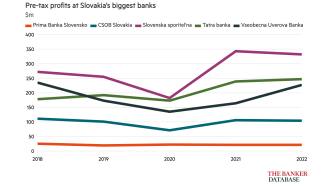Ukraine’s corporate bond market is a sleeping giant that is beginning to stir. Volumes of issuance have been building slowly for several years but began to accelerate last year on the back of blistering economic growth.
The past 18 months have been more difficult as Ukraine is still trying to emerge from the political chaos caused by the Orange Revolution that ousted the administration of Leonid Kuchma in early spring of 2005, who was replaced by President Viktor Yushchenko.
Bankers were expecting the corporate bond to leap ahead with yields falling and demand surging. Instead, supply is still running significantly ahead of demand. Nevertheless, the volume of bonds issued in the first six months of this year was more than was issued in all of 2005: the total volume of corporate bonds has risen from a paltry $130m in 2001 to $1.6bn in 2005 and an estimated $1.7bn in the first six months of this year. Leading the charge is Ukraine’s phalanx of companies catering to the flourishing retail sector.
Turning orange
The economy that was growing by 12% in 2004 tanked following the Orange Revolution that winter as businessmen froze investment plans en masse to see what the administration of newly elected Viktor Yushchenko and his allies would do. But since the start of this year the economy has roared back into life, growing 9.3% in June year-on-year, as the fear of a pogrom against the oligarchs and mass renationalisation failed to appear.
However, it is still early days for Ukrainian corporate bonds and the hryvnia-denominated fixed income market is still dominated by sovereign issues. As of the start of this year, the government had Hrv19bn ($3.8bn) of local currency bonds outstanding – about 5.4% of GDP. The corporate bond market remains shallow with Hrv8bn of issues, the equivalent of 1% of GDP, and municipal bonds, while growing fast, are still in their infancy with Hrv350m ($70m), 0.1% of GDP, worth outstanding, according to Alex Valchishen, a fixed income analyst at ING in Kiev.
Market take-off
2005 was a good year for the corporate bond market, which is tapping into rapidly increasing personal incomes and the cash pouring into a growing pool of liquidity in the domestic banking sector.
Volumes of bond issues rose fast, from Hrv132m in 1999 to Hrv4bn in 2002, but then got stuck there until 2005, when they doubled, and looked like doubling again this year despite the political brouhaha.
The capital of the Ukrainian banking system increased by 19% in the first six months of this year to $50bn – equivalent to just over half the size of the economy expected at the end of this year. Retail deposits surged by 44% in the same period to $16.7bn, according to the National Bank of Ukraine (NBU), after increasing 76% in all of 2005 year-on-year. Corporate deposits are growing more slowly, but were also up $12.8bn in the first six months of this year.
Driving this expansion is the rapid rise in personal incomes, which have grown in double digits for several years and were up by a third in the first four months of this year to a total of $25bn a month.
Banks, supermarkets, real estate developers and food processing companies are making money hand over fist, irrespective of what their political leaders are arguing about, and are becoming increasingly desperate for investment capital to maintain their growth.
Issuance flurry
Banks and municipalities have made up the vanguard of corporate bond issuers, but are already giving way to companies catering directly to the consumption boom. A flurry of construction companies came to market in December 2005, raising Hrv490m between them, and 15 issues that month from consumer-related companies was more than double the total issuance in the first half of 2005, raising Hrv1.3bn-worth of corporate bonds. By the end of 2005, a total of 248 bond issues had been registered, worth Hrv6.2bn.
This trend has continued into 2006 as the base of consumer companies issuing bonds continues to broaden and Ukrainian retail companies begin to cross the border into the larger markets to the north. An estimated Hrv8.5bn of bonds have already been issued in the first six months of this year, Hrv6.8bn of them by companies.
Among the consumer company issues since the start of the year was Ukraine’s leading chicken farm, Druzhba Narodiv Nova, a subsidiary of Myronivskiy Hliboprodukt, Ukraine’s leading meat and poultry producer. The company operates 192 poultry farms and had a spectacular year in 2005 after net sales almost doubled to $96m, the EBITDA margin was up 67% and its return on equity was a whopping 48%. Its Hrv200m two-year domestic bond issue was much anticipated and was expected to be placed with a yield of 14% in August – almost as much as the entire banking sector collectively issued in the first six months of last year. However, demand was disappointingly low and the bond came in with a yield of 10%.
Still, analysts say that for every corporate bond issue there are several more waiting in the wings until the political scene quietens down. “We expect the local bond market to revive after political uncertainty diminishes and to benefit also from the renewal of primary Treasury auctions expected later this year. For all this, we view some of the upcoming corporate bond issues as attractive opportunities to invest,” Dragon Capital said in a report at the end of July.
Infrastructure hindrance
Issues are typically Hrv20m-Hrv100m with maturities ranging from two to five years with yields running from 12%-16%. Analysts were expecting yields to fall below 10% this year, but politics is weighing on demand and has kept yields high. Banks are still the biggest issuers of bonds, according to Dragon Capital, but their share has fallen to 60% of the “market-orientated” issuance volume and is expected to fall further. However, the bulk of issues are still “technical issues”.
“Technical issues are widespread in Ukraine, although their shares are gradually reducing. This includes private placements, that ostensibly are public, but end up with a single investor, bonds issued to finance apartment purchases and bonds redeemed in kind (used to pay for real estate),” says Olena Bilan, a fixed income analyst at Dragon Capital.
The end of political uncertainty that was expected to accompany the formation of a new coalition government was expected to give the bond market an immediate fillip but any growth will quickly run into a ceiling created by the rudimentary state of the market’s infrastructure. Mr Yushchenko identified the need to reform the domestic capital markets as a top priority after taking office last spring, but the government is still only stepping off square one. The president signed off on a new investment law the day before parliamentary elections in March, which replaced the out-of-date rules that were untouched since they were introduced in the first days of independence in 1991.
“In effect, the 1991 law laid the foundation for the market without reference to the context of market practice – as no market existed at that time,” says Bogdan Lupiy, the executive director of Ukraine’s First Securities Trading System.
The new law introduces a raft of badly needed measures and even goes beyond that of most of Ukraine’s neighbours by introducing concepts such as insider trading. Corporate bonds will also receive a boost from the changes, as banks will soon be able to use certain classes of corporate bonds as collateral when borrowing from the National Bank of Ukraine.
“There are many bottlenecks to capital market development: huge loopholes in joint stock companies’ law, poor corporate governance, pension duty levied on foreign currency purchase, to name the most acute,” says Ms Bilan.
However, it will still take time for the market to move from the low-volume informal trading that dominates the action now to more formal exchange-based deals that can create a really liquid secondary market.
“In Russia and the West, almost all the bond trading is done on the exchange with automatic settlement. There is very little over-the-counter trading. It means there is almost no counterparty risk,” says Peter Grisham, fixed income analyst at Renaissance Capital. “That is not true with Ukraine, where the exchanges are underdeveloped, there are problems with registrars, depositories and settlement.”
Stymied trading
The poor state of Ukraine’s infrastructure means that a significant secondary market has yet to develop. Russia saw rapid diversification of bondholders after its market took off in 2001, but Ukrainian bonds are almost exclusively held by the country’s biggest banks, which tend to hold their paper to maturity.
“The [traded] volumes are growing, but the nature of the market has barely changed in the last two or three years. If you look at the breakdown of who is buying bonds three years ago then you will see very little change to today,” says Mr Grisham.
Trading has also been stymied by the short maturities. While the duration of bonds has grown to an average of three years, almost all bonds are issued with six-month or nine-month put options built in so most bond holders tend to hold them to maturity.
“Almost all the bonds issued so far have put options after six or nine months, so buyers tend to hold them to maturity as it is not long to wait until the put options become due,” says ING’s Mr Valchishen. “However, we are now seeing the first bonds with 12-month put options and some issuers want to issue bonds with no put options at all. Once bonds with real maturities of over two years begin to appear, then we will see the development of a real secondary market.”
The little trading that exists is concentrated in about three names: medium-sized gas distributor Galnaftogaz, supermarket chain Velyka Kyshenya and automotive producer ZAZ.
Struggle for consumers
Ukraine’s bank system is good, but there is an almost total lack of domestic institutional investors like insurance companies and pension funds, which are traditional consumers of bonds. Mr Grisham says that until investors other than banks appear, the secondary market will struggle to get off the ground.
Foreign investors – largely hedge funds – are a possible source of liquidity to substitute for domestic institutional investors, but they are only now dipping their toes into the corporate bond market. While foreign investors hold between 50% and 70% of sovereign bonds, they are believed to hold at most 15% of corporate bonds, concentrated in a few blue chips.
“Banks are the most active traders. There was a boom among foreign investors at the beginning of 2005, when expectations of hryvnia appreciation prevailed. Now foreign investors are much less active due to prolonged political instability and uncertainty of future exchange rate policy,” says Ms Bilan.
Investors will now be watching carefully the issuance of government bonds as the state has yet to make use of a provision for Hrv4.4bn of domestic sovereign bond issues in the budget, as well as the possibility of a Eurobond, to get a handle on both the mood and prices.











